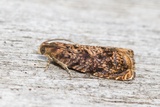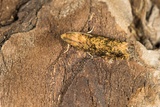Aspila lobarzewskii (Nowicki, 1860) Species
Last modified: Nov. 24, 2025, 7:39 p.m.
A very rare species in Belgium, more recorded in the north of the country. Possibly overlooked as larval feeding signs can be found quite easily.
Details
- Classification
- Family: Tortricidae > Subfamily: Olethreutinae > Tribus: Grapholitini > Genus: Aspila > Species: Aspila lobarzewskii
- Vernacular names
- Kleine fruitmot (NL), Small Fruit Moth, Kent Fruit Piercer (EN), Petite tordeuse des fruits (FR), Kleiner Fruchtwickler (DE)
- First mention in Belgium
- Meert R. 2015. Eerste vondst van Grapholita lobarzewskii (Lepidoptera: Tortricidae) voor België. — Phegea 43(1): 13–14. On page 13. view page
- Status
-
Native
First Belgian record of Grapholita lobarzewskii on 20 and 27 May 2014 in an orchard at Lebbeke (OV), using pheromones for this species, leg. R. Meert.
Distribution
Imago
Wingspan 13–14 mm. The moth resembles Grapholita janthinana but is larger and more mottled lacking discrete fascia and with clearer pale costal strigulae.
Forewing chocolate-brown to orangy-brown with pale-brown mottling with an obscurely strigulate dorsal patch is discernable, ocellus is marked with a few black streaks. Labial palps are whitish. A bristly shoulder-patch of pale brown to orange-brown elongate scales.
Bionomics
The larva bores and feeds in apples and plums. One or often two holes are visible in the fruit where brown frass is ejected. Sometimes a short dark mine can be seen underneath the fruit skin. From July onwards (at least on apple) the larva creates several superficial lines on the epidermis that radiate from the central hole. These traces remain on the apple untill autumn and can easlily be used to confirm the presence of the species. Hibernation and pupation takes place in a cocoon elsewhere, often under loose bark.
A specific pheromone is available for this species.
The adults come to light.
Flight periods
The adults fly from mid-May till mid-July with most numbers during June.
Habitat
Orchards, gardens and other habitats where the host plants occur.













